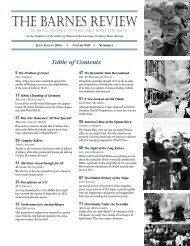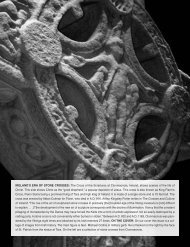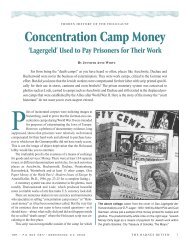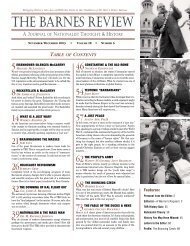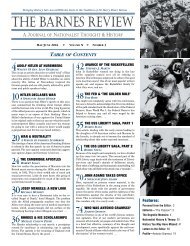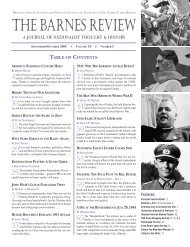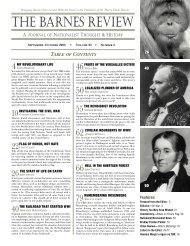Click her to look at this book's Table - The Barnes Review
Click her to look at this book's Table - The Barnes Review
Click her to look at this book's Table - The Barnes Review
- TAGS
- barnes
- barnesreview.org
Create successful ePaper yourself
Turn your PDF publications into a flip-book with our unique Google optimized e-Paper software.
Dissecting the Holocaust<br />
<strong>The</strong> Growing Critique<br />
of ‘Truth’ and ‘Memory’<br />
Edited<br />
by<br />
Germar Rudolf<br />
<strong>The</strong>ses & Dissert<strong>at</strong>ions Press
HOLOCAUST Handbooks Series, vol. 1:<br />
Germar Rudolf (ed.):<br />
Dissecting the Holocaust. <strong>The</strong> Growing Critique of ‘Truth’ and ‘Memory’.<br />
Transl<strong>at</strong>ed by Vic<strong>to</strong>r Diodon<br />
Chicago (Illinois): <strong>The</strong>ses & Dissert<strong>at</strong>ions Press, August 2003<br />
Second, corrected, paperback edition<br />
ISBN 0-9679856-2-5<br />
ISSN 1529-7748<br />
Original German edition:<br />
Gauss, Ernst (i.e., Germar Rudolf) (Hg.):<br />
Grundlagen zur Zeitgeschichte.<br />
Ein Handbuch über strittige Fragen des 20. Jahrhunderts.<br />
Tübingen: Grabert, 1994<br />
Veröffentlichungen des Institutes für deutsche Nachkriegsgeschichte; Bd. 22<br />
ISBN 3-87847-141-6<br />
ISSN 0564-4186<br />
Original German edition: © November 1994 by Grabert-Verlag, Postfach 1629, D-72006 Tübingen<br />
First English edition: © 2000 by <strong>The</strong>ses & Dissert<strong>at</strong>ions Press, P.O. Box 64, Capshaw, Alabama 35742,<br />
USA (ISBN 0-9679856-0-9)<br />
Second English edition: © 2003 by <strong>The</strong>ses & Dissert<strong>at</strong>ions Press, P.O. Box 257768, Chicago, Illinois<br />
60625, USA<br />
Transl<strong>at</strong>ed by Vic<strong>to</strong>r Diodon<br />
Online:<br />
German: www.vho.org/D/gzz<br />
English: www.vho.org/GB/Books/dth<br />
All Rights reserved. No part of <strong>this</strong> book may be reproduced in any manner wh<strong>at</strong>soever without<br />
written permission except in the case of brief quot<strong>at</strong>ion in articles and reviews.
<strong>Table</strong> of Content<br />
Page<br />
Preface..................................................................................................................................................7<br />
ROBERT FAURISSON<br />
<strong>The</strong> Controversy about the Extermin<strong>at</strong>ion of the Jews · An Introduction..........................................13<br />
GERMAR RUDOLF<br />
<strong>The</strong> Case of Walter Lüftl · Contemporary His<strong>to</strong>ry and the Justice System .......................................61<br />
WERNER RADEMACHER<br />
<strong>The</strong> Value of Testimony and Confessions Concerning the Holocaust...............................................85<br />
MANFRED KÖHLER<br />
Witnesses <strong>to</strong> the Gas Chambers of Auschwitz.................................................................................133<br />
ROBERT FAURISSON<br />
<strong>The</strong> German Justice System: A Case Study.....................................................................................145<br />
CLAUS JORDAN<br />
Holocaust Victims: A St<strong>at</strong>istical Analysis .......................................................................................181<br />
GERMAR RUDOLF<br />
<strong>The</strong> Gas Vans: A Critical Assessment of the Evidence ...................................................................215<br />
INGRID WECKERT<br />
Do Pho<strong>to</strong>graphs Prove the NS Extermin<strong>at</strong>ion of the Jews?.............................................................243<br />
UDO WALENDY<br />
Air Pho<strong>to</strong> Evidence ..........................................................................................................................269<br />
JOHN CLIVE BALL<br />
N<strong>at</strong>ional Socialist Concentr<strong>at</strong>ion Camps: Legend and Reality ........................................................283<br />
JÜRGEN GRAF<br />
Some Details of the Central Construction Office of Auschwitz........................................................311<br />
HANS JÜRGEN NOWAK AND WERNER RADEMACHER<br />
Some Consider<strong>at</strong>ions about the ‘Gas Chambers’ of Auschwitz and Birkenau................................337<br />
GERMAR RUDOLF<br />
<strong>The</strong> Crema<strong>to</strong>ria Ovens of Auschwitz and Birkenau.........................................................................373<br />
CARLO MATTOGNO<br />
<strong>The</strong> Gas Chambers of Majdanek......................................................................................................413<br />
CARLO MATTOGNO<br />
Diesel Gas Chambers: Ideal for Torture – Absurd for Murder ........................................................435<br />
FRIEDRICH PAUL BERG<br />
<strong>The</strong> Treblinka Holocaust..................................................................................................................471<br />
ARNULF NEUMAIER<br />
Babi Yar: Critical Questions and Comments ...................................................................................501<br />
HERBERT TIEDEMANN<br />
Reprisals and Orders From Hig<strong>her</strong> Up.............................................................................................529<br />
KARL SIEGERT, WITH COMMENTS BY GERMAR RUDOLF<br />
5
GERMAR RUDOLF (ED.) · DISSECTING THE HOLOCAUST<br />
Appendix 1: Wood Preserv<strong>at</strong>ion through Fumig<strong>at</strong>ion with Hydrogen Cyanide: Blue<br />
Discolor<strong>at</strong>ion of Lime- and Cement-Based Interior Plaster .......................................557<br />
6<br />
HELMUT WEBER, WITH COMMENTS BY GERMAR RUDOLF<br />
Appendix 2: Dissecting the Holocaust: Expert Report ....................................................................563<br />
JOACHIM HOFFMANN<br />
Appendix 3: Censorship in Germany? Never! Unless… .................................................................567<br />
ANTON MÄGERLE<br />
A Brief His<strong>to</strong>ry of Holocaust Revisionism ......................................................................................579<br />
WILLIS A. CARTO<br />
Bibliography.....................................................................................................................................583<br />
Index.................................................................................................................................................601<br />
“<strong>The</strong> N<strong>at</strong>ural sciences [like ot<strong>her</strong> scholary disciplines] are extremely conserv<strong>at</strong>ive and dogm<strong>at</strong>ic. Any<br />
corrobor<strong>at</strong>ion of a paradigm is welcome, w<strong>her</strong>eas any innov<strong>at</strong>ion or revision will long meet with resistance;<br />
the instinct for preserv<strong>at</strong>ion (including self-preserv<strong>at</strong>ion!) is stronger than the search for truth. T<strong>her</strong>efore,<br />
new findings usually gain acceptance only when sufficient numbers of researc<strong>her</strong>s vouch for them: then the<br />
dogm<strong>at</strong>ic st<strong>at</strong>us quo <strong>to</strong>pples, a ‘scientific revolution’ occurs, a new paradigm replaces the old […] <strong>The</strong><br />
bot<strong>to</strong>m line is th<strong>at</strong> no student, no researc<strong>her</strong> and no layman should believe any facts <strong>to</strong> be ‘conclusively<br />
proven’, even if the textbooks present them as such […]”<br />
Professor Walter Nagl, Ph.D., Gentechnologie und Grenzen der Biologie,<br />
Wissenschaftliche Buchgesellschaft, Darmstadt 1987, pp. 126f.<br />
“<strong>The</strong> error [of numbers of Auschwitz victims], though committed a long time ago and by ot<strong>her</strong>s,<br />
remains tendentious. And it was ‘our’ error, if ‘our’ refers <strong>to</strong> the enemies of fascism and racism. […]<br />
I admit th<strong>at</strong> it is sometimes necessary <strong>to</strong> conceal the truth – i.e., <strong>to</strong> lie – <strong>at</strong> times even for noble reasons,<br />
for example out of pity or tact. But it is always profitable <strong>to</strong> know why one does so,<br />
and wh<strong>at</strong> such devi<strong>at</strong>ions from the truth entail […].<br />
While truth is not always good, lies are much more often evil […].”<br />
Ernest Skalski, Der Spiegel, no. 30/1990, p. 111<br />
“A democracy requires free citizens who are willing <strong>to</strong> say publicly<br />
unpopular things <strong>to</strong> provoke critical deb<strong>at</strong>e.”<br />
Robert Reich, Los Angeles Times, May 13, 1998, p. B13<br />
Throughout <strong>this</strong> book, double quot<strong>at</strong>ion marks (“”) are used for “quot<strong>at</strong>ions” (set always in italics), single<br />
marks (‘’) for ot<strong>her</strong>wise non-emphasized text of ‘so-called’ and ‘so-<strong>to</strong>-say’ character (except when used for<br />
quot<strong>at</strong>ions inside quot<strong>at</strong>ions). Quot<strong>at</strong>ions are introduced once with a single “-mark and ended with a ”-mark<br />
(<strong>to</strong> break with the American tradition <strong>to</strong> introduce every paragraph in a quot<strong>at</strong>ion with a “-mark, but never<br />
closing it, which, strictly speaking, is an “untermin<strong>at</strong>ed string error”). Entire sentences or paragraphs of<br />
quoted text are rendered in small italic font and left indent<strong>at</strong>ion. Any addition <strong>to</strong> quoted text is rendered nonitalic<br />
and surrounded by brackets, so are added omission ellipses […], which could ot<strong>her</strong>wise not be distinguished<br />
from ellipses in the original.<br />
Titles of books and journals are set in italics without quot<strong>at</strong>ion marks. References have the order: a) books:<br />
author(s)/edi<strong>to</strong>r(s), title, [volume,] [edition,] [publishing house,] <strong>to</strong>wn year[, pages]; b) journals: author(s),<br />
[“title of article”], name of journal, volume[(issue)] (year)[, pages] (items in brackets optional).
Preface *<br />
ROBERT FAURISSON<br />
His<strong>to</strong>rical revisionism is the gre<strong>at</strong> intellectual adventure of the end of the 20 th century.<br />
Despite its size, the present handbook offers only a glimpse of th<strong>at</strong> adventure; and so it seems<br />
necessary <strong>her</strong>e first <strong>to</strong> specify the precise his<strong>to</strong>rical problem upon which the Revisionists have concentr<strong>at</strong>ed<br />
their research, then how revisionism arose in the 1940s and how it developed in the years<br />
1950 <strong>to</strong> 1978; and finally how it really <strong>to</strong>ok off in the years 1978 <strong>to</strong> 1979, <strong>to</strong> experience such an increase<br />
in the present day th<strong>at</strong> nothing any longer seems likely <strong>to</strong> halt its onward march.<br />
In the Nuremberg Trial (1945-46), Germany had been judged and condemned for “crimes against<br />
peace”, for “war crimes” and for “crimes against humanity”. <strong>The</strong> Revisionists have been led in a<br />
way by their successive discoveries concerning these three points <strong>to</strong> call for a revision of the Nuremberg<br />
Trial. Regarding the first two points, the Revisionists have been able <strong>to</strong> present their arguments<br />
without <strong>to</strong>o much difficulty, and it is probable th<strong>at</strong> no serious his<strong>to</strong>rian <strong>to</strong>day would contend<br />
th<strong>at</strong> anyone is in a position <strong>to</strong> lecture Germany concerning “crimes against peace” and “war<br />
crimes”: as a m<strong>at</strong>ter of fact, it has become evident th<strong>at</strong> the Allies bear their share of responsibility in<br />
the starting of the war, and th<strong>at</strong> they themselves committed innumerable “war crimes” (if th<strong>at</strong> expression<br />
has any meaning, given th<strong>at</strong> war itself may be held a crime). On the ot<strong>her</strong> hand, concerning<br />
the third point, th<strong>at</strong> is with regard <strong>to</strong> “crimes against humanity”, they keep on dinning in<strong>to</strong> our ears<br />
th<strong>at</strong> Germany <strong>at</strong>tained a peak of horror all <strong>her</strong> own with the ‘genocide’ of the Jews. It is on the<br />
study of <strong>this</strong> precise point th<strong>at</strong> the Revisionists have specifically concentr<strong>at</strong>ed their efforts. And so,<br />
by degrees, his<strong>to</strong>rical revisionism has become wh<strong>at</strong> the Americans now call ‘Holocaust revisionism’.<br />
According <strong>to</strong> the accusers, Germany was not content just <strong>to</strong> persecute the Jews, <strong>to</strong> deport them<br />
and put them in<strong>to</strong> concentr<strong>at</strong>ion camps or forced labor camps; those ‘crimes’ – as every his<strong>to</strong>rian<br />
knows – are unfortun<strong>at</strong>ely frequent in the his<strong>to</strong>ry of mankind, and we have only <strong>to</strong> turn on our TV<br />
sets <strong>to</strong>day <strong>to</strong> note th<strong>at</strong> all kinds of human societies continue <strong>to</strong> suffer such ‘crimes’. Germany, <strong>her</strong><br />
accusers still contend, went far beyond th<strong>at</strong>. Taking a giant leap in horror, in 1941-1942 she allegedly<br />
decided on the <strong>to</strong>tal extermin<strong>at</strong>ion of the European Jews, and in order <strong>to</strong> perpetr<strong>at</strong>e <strong>this</strong> specific<br />
crime, supposedly devised and utilized a specific weapon: the homicidal gas chamber (or gas van).<br />
Making use of abominable chemical slaughterhouses, she allegedly began a collective assassin<strong>at</strong>ion<br />
of industrial proportions. Th<strong>at</strong> crime (the genocide) and th<strong>at</strong> weapon used in the crime (the homicidal<br />
gas chamber) are in th<strong>at</strong> sense inseparable, and it is consequently impossible <strong>to</strong> maintain, as<br />
some do, “th<strong>at</strong> whet<strong>her</strong> or not t<strong>her</strong>e was a gas chamber makes no fundamental difference”. Germany<br />
thus presumably committed an intrinsically evil crime against the Jews. <strong>The</strong> Jews say furt<strong>her</strong><br />
th<strong>at</strong> the whole world knowingly allowed the Germans <strong>to</strong> perpetr<strong>at</strong>e th<strong>at</strong> crime. <strong>The</strong> paradoxical result<br />
of so enormous an accus<strong>at</strong>ion is th<strong>at</strong> <strong>to</strong>day in the dock of the accused, ‘criminals’ Hitler,<br />
Himmler, and Goering are joined by their ‘accomplices’, Roosevelt, Churchill, Stalin, Pope Pius<br />
XII, and the Intern<strong>at</strong>ional Committee of the Red Cross, as well as the represent<strong>at</strong>ives of many ot<strong>her</strong><br />
countries and organiz<strong>at</strong>ions.<br />
Things are such th<strong>at</strong> in the United St<strong>at</strong>es, for instance, from Los Angeles <strong>to</strong> Washing<strong>to</strong>n, they<br />
hammer away <strong>at</strong> it in the ‘Holocaust museums’, w<strong>her</strong>e <strong>to</strong>day’s Jews have set themselves up as accusers<br />
of the whole world; they go so far as <strong>to</strong> incrimin<strong>at</strong>e the Jews in positions of responsibility<br />
* This preface was transl<strong>at</strong>ed from the French original by Tom Kerr.<br />
7
GERMAR RUDOLF (ED.) · DISSECTING THE HOLOCAUST<br />
who were living in Europe, in America, or in Palestine during the war: they have the effrontery <strong>to</strong><br />
reproach them for their collabor<strong>at</strong>ion or their indifference, or for the spinelessness of their reaction<br />
<strong>to</strong> the ‘system<strong>at</strong>ic extermin<strong>at</strong>ion’ of their co-religionists.<br />
<strong>The</strong> earliest rumors of a gassing of Jews by the Germans apparently circul<strong>at</strong>ed in December of<br />
1941 in the Warsaw ghet<strong>to</strong>. 1 But throughout the war such rumors found only a feeble echo in circles<br />
hostile <strong>to</strong> Germany. One has only <strong>to</strong> read a book such as th<strong>at</strong> of Walter Laqueur’s <strong>The</strong> Terrible Secret<br />
2 <strong>to</strong> realize th<strong>at</strong> the skepticism was general. People still held long-lived memories during the<br />
Second World War of the invention of <strong>at</strong>rocities during the First World War, when s<strong>to</strong>ries were already<br />
being spread about the gassing of civilians (in churches or elsew<strong>her</strong>e), as well as s<strong>to</strong>ries about<br />
corpse fac<strong>to</strong>ries. <strong>The</strong> Foreign Office saw the new rumors of the Second World War only as Jewish<br />
inventions, and many in American circles shared th<strong>at</strong> conviction. 3 Edward Beneš, President of<br />
Czechoslovakia (in exile in London), announced in November 1942, after inquiry by his staff, th<strong>at</strong><br />
the Germans, contrary <strong>to</strong> wh<strong>at</strong> had been reported <strong>to</strong> him, were not extermin<strong>at</strong>ing the Jews. 4 <strong>The</strong><br />
American Jew, Felix Frankfurter, a Supreme Court judge, st<strong>at</strong>ed <strong>to</strong> Jan Karski on the subject: “I<br />
can’t believe you.” 5 In August of 1943, Cordell Hull, Secretary of St<strong>at</strong>e, warned the U.S. ambassador<br />
in Moscow by telegram th<strong>at</strong> in planning a joint Allied st<strong>at</strong>ement on “the German crimes in Poland”, it<br />
would be advisable <strong>to</strong> elimin<strong>at</strong>e any mention of the gas chambers, since, as the British pointed out,<br />
t<strong>her</strong>e was “insufficient evidence” in the m<strong>at</strong>ter. 6<br />
Even after the war, high-ranking Allied officials such as Eisenhower, Churchill and De Gaulle, in<br />
their respective memoirs, would refrain from mentioning the existence and oper<strong>at</strong>ion of ‘Nazi gas<br />
chambers’. In a manner of speaking, all these skeptics were in their own way Revisionists. Neit<strong>her</strong><br />
the V<strong>at</strong>ican, nor the Intern<strong>at</strong>ional Committee of the Red Cross, nor the anti-German Resistance<br />
acted as if they put any faith in the rumors which, moreover, <strong>to</strong>ok the most fantastic forms: invariably<br />
the Germans were said <strong>to</strong> be extermin<strong>at</strong>ing the Jews, but as <strong>to</strong> the methods of extermin<strong>at</strong>ion<br />
they were most varied: steam, gas, electricity, fire, acid, an injection of air, drowning, vacuum<br />
pump, etc. Why gas wound up the winner in the Greuelpropaganda competition is not exactly<br />
known.<br />
<strong>The</strong> Frenchman Paul Rassinier was the first true Revisionist of the postwar period. In 1950, <strong>this</strong><br />
former deportee began <strong>to</strong> denounce the “myth of the gas chambers” in Le Mensonge d’Ulysse 7 and<br />
in a whole series of works. In 1976, the American engineer Arthur Robert Butz published <strong>The</strong> Hoax<br />
of the Twentieth Century 8 which is the most profound revisionist work written <strong>to</strong> d<strong>at</strong>e on the subject<br />
of the alleged genocide and the gas chambers. In 1979, a German judge, Dr. Wilhelm Stäglich, in<br />
1<br />
“S<strong>to</strong>ckholm, Dec. 21 (JTA). – More than 1,000 victims of spotted fever in the densely crowded Warsaw ghet<strong>to</strong> have<br />
been put <strong>to</strong> de<strong>at</strong>h by gas [�], it is learned <strong>to</strong>day from reliable sources” (<strong>The</strong> Jewish Telegraphic Agency Bulletin,<br />
December 22, 1941, p. 1).<br />
2<br />
<strong>The</strong> Terrible Secret. An Investig<strong>at</strong>ion in<strong>to</strong> the Suppression of Inform<strong>at</strong>ion about Hitler’s “Final Solution”, Weidenfeld<br />
and Nicolson, London 1980.<br />
3<br />
Ibid., see “Foreign Office” in the index as well as pp. 83, 91, 94, 116, 225, etc.<br />
4<br />
5<br />
8<br />
Ibid., pp. 162f.<br />
Ibid., p. 237.<br />
6 Foreign Rel<strong>at</strong>ions of the United St<strong>at</strong>es, Diplom<strong>at</strong>ic Papers, US Printing Office, Washing<strong>to</strong>n 1963, vol.1 of 1943, pp.<br />
416f.<br />
7 Le Mensonge d’Ulysse, La Librairie française, Paris 1950 (online: abbc.com/aaargh/fran/archRassi/prmu/<br />
prmu.html).<br />
8 <strong>The</strong> Hoax of the Twentieth Century. <strong>The</strong> Case Against the Presumed Extermin<strong>at</strong>ion of the Jews, Institute for His<strong>to</strong>rical<br />
<strong>Review</strong>, P.O.Box 2739, Newport Beach, California 92659, USA. It is advisable <strong>to</strong> read the 1993 edition which<br />
contains, in three separ<strong>at</strong>e supplements, the lectures given by the author in 1979, 1982, and 1992. In the 1982 lecture,<br />
I recommend the dazzling demonstr<strong>at</strong>ion contained in pages 350-362 about “<strong>The</strong> s<strong>to</strong>ry of the invisible elephant.”
ROBERT FAURISSON · PREFACE<br />
turn published Der Auschwitz Mythos, 9 a study devoted principally <strong>to</strong> the manner in which the<br />
German courts of law were able <strong>to</strong> collabor<strong>at</strong>e in the fabric<strong>at</strong>ion of a myth, somewh<strong>at</strong> the same way<br />
th<strong>at</strong> the judges of the witchcraft trials in the past, above all from 1450 <strong>to</strong> 1650, lent their support <strong>to</strong><br />
even the most preposterous s<strong>to</strong>ries <strong>to</strong>ld about the stake, the grill and S<strong>at</strong>an’s ovens.<br />
Without wishing <strong>to</strong> diminish the gre<strong>at</strong> importance of Paul Rassinier, of Arthur Butz, and of<br />
Wilhelm Stäglich, I hope I may be permitted <strong>to</strong> say th<strong>at</strong>, <strong>at</strong> the end of the seventies, revisionism<br />
would for once become m<strong>at</strong>erialistic and scientific with the research conducted on the ground by<br />
Ditlieb Felderer, the Swedish Revisionist, as well as with my own discoveries <strong>at</strong> Auschwitz proper,<br />
my observ<strong>at</strong>ions on the use of Zyklon B for disinfest<strong>at</strong>ion (delousing), and my reflections on the<br />
utiliz<strong>at</strong>ion of hydrogen cyanide gas in the gas chambers of US-American penitentiaries for the execution<br />
of men condemned <strong>to</strong> de<strong>at</strong>h. Neit<strong>her</strong> Rassinier, nor Butz, nor Stäglich had gone <strong>to</strong> Poland <strong>to</strong><br />
the supposed sites of the crime, and none of them, moreover, had really utilized <strong>to</strong> their fullest extent<br />
the arguments of a physical, chemical, <strong>to</strong>pographical, and architectural n<strong>at</strong>ure which <strong>to</strong>day, following<br />
the investig<strong>at</strong>ions of D. Felderer and my own inquiries, are currently employed by the<br />
younger gener<strong>at</strong>ion of revisionist researc<strong>her</strong>s. As for the Jewish researc<strong>her</strong>s, who defend the theory<br />
of the extermin<strong>at</strong>ion of the Jews, they have resolutely remained wh<strong>at</strong> I call paper his<strong>to</strong>rians: Léon<br />
Poliakov and Raul Hilberg have stayed with paper and words and in the realm of specul<strong>at</strong>ion. 10<br />
It is surprising th<strong>at</strong> <strong>this</strong> vast field of properly scientific argument was not seen by Germany, which<br />
has so many chemists and engineers, and by the USA, itself with no lack of scientific minds who<br />
even had the examples right t<strong>her</strong>e before them of their own gas chambers using hydrogen cyanide.<br />
In 1976 <strong>at</strong> Auschwitz, I discovered both the exact configur<strong>at</strong>ion of the crema<strong>to</strong>ries th<strong>at</strong> were supposed<br />
<strong>to</strong> contain homicidal gas chambers, of the delousing gas chambers (Entlausungsgaskammern),<br />
and the plans (hidden until then) of certain crema<strong>to</strong>ries. In 1978/1979, I published two articles<br />
in Le Monde 11 in which I summarized some of my discoveries. In 1979, <strong>at</strong> the first conference<br />
of the Institute for His<strong>to</strong>rical <strong>Review</strong>, in Los Angeles, I presented those discoveries in detail.<br />
Among those present in the audience was one Ernst Zündel, a German now living in Toron<strong>to</strong>. From<br />
1985 on, <strong>this</strong> man would prove <strong>to</strong> be the most ardent, the most effective, and also – though many<br />
seem not <strong>to</strong> know it – one of the most innov<strong>at</strong>ive minds among all the Revisionists. He was the first<br />
<strong>to</strong> understand why I so insisted on the chemical argument and, in particular, on the importance th<strong>at</strong><br />
the technology of the American gas chambers in the thirties and forties had for us. He unders<strong>to</strong>od<br />
why I wanted a specialist in these American gas chambers <strong>to</strong> go and examine the alleged execution<br />
gas chambers on the spot, in Poland. Thanks <strong>to</strong> my correspondence with American penitentiaries in<br />
the seventies, I had already discovered such a specialist in the person of Fred Leuchter, but it was<br />
Ernst Zündel, and he alone, who had the brilliant idea of asking him not only <strong>to</strong> make an examin<strong>at</strong>ion<br />
of the buildings, but <strong>to</strong> take constituent samples of m<strong>at</strong>erial from the disinfest<strong>at</strong>ion gas chambers<br />
on the one hand and from the alleged execution gas chambers on the ot<strong>her</strong>. In February of<br />
1988, he <strong>to</strong>ok the risk of sending Fred Leuchter and an entire team <strong>to</strong> Poland <strong>at</strong> his own expense <strong>to</strong><br />
study the alleged gas chambers of Auschwitz, Birkenau and Majdanek. <strong>The</strong> results of the study of<br />
the buildings and of the analysis of the samples taken proved spectacular and <strong>to</strong>tally in favor of the<br />
9 Der Auschwitz-Mythos. Legende oder Wirklichkeit? Eine kritische Bestandsaufnahme, Grabert-Verlag, Tübingen<br />
1979 (online: vho.org/D/dam). <strong>The</strong> work was destroyed on orders of the German authorities. A second edition was<br />
published in Gre<strong>at</strong> Britain: Der Auschwitz-Mythos […], Vorwort von Mark Weber, Beitrag von R. Faurisson, Bemerkungen<br />
von Revilo Oliver, Charles E. Weber u. Arthur R. Butz, His<strong>to</strong>rical <strong>Review</strong> Press, 20 Madeira Place,<br />
Brigh<strong>to</strong>n, Sussex, England BN2 1TN, 1984. In both editions, the pho<strong>to</strong>graphic document<strong>at</strong>ion is from my archives.<br />
10 For a detailed critique of Raul Hilberg’s work see Jürgen Graf, <strong>The</strong> Giant With Feet of Clay. Raul Hilberg and his<br />
Standard Work on the “Holocaust”, <strong>The</strong>ses & Dissert<strong>at</strong>ions Press, Capshaw, AL, 2001 (online:<br />
vho.org/GB/Books/Giant) (note of the edi<strong>to</strong>r).<br />
11 Le Monde, 29 December 1978 and 16 January 1979.<br />
9
GERMAR RUDOLF (ED.) · DISSECTING THE HOLOCAUST<br />
revisionist thesis. In the following years, ot<strong>her</strong> reports would confirm the basic accuracy of the<br />
Leuchter Report: 12 first the very learned report of Germar Rudolf, 13 then the involved and secret<br />
specialist’s report of the Poles, 14 and finally the study of the Austrian Walter Lüftl. 15<br />
It only remains <strong>to</strong> be said th<strong>at</strong> if Germany’s accusers are not s<strong>at</strong>isfied with these studies, they are<br />
<strong>at</strong> liberty <strong>to</strong> initi<strong>at</strong>e their own specialist’s report. Wh<strong>at</strong> has kept them from doing it publicly, in<br />
broad daylight, these past fifty years?<br />
We must understand the disarray of Germany’s accusers in the face of revisionism’s successes.<br />
For half a century they have sincerely believed th<strong>at</strong> the tragedy undergone by the Jews during the<br />
Second World War was of exceptional seriousness and magnitude, w<strong>her</strong>eas, when reduced <strong>to</strong> its<br />
proper proportions – th<strong>at</strong> is, without genocide and without gas chambers – their tragedy was just<br />
one of many ot<strong>her</strong> tragedies of th<strong>at</strong> terrible conflict. Under the thrust of revisionist inquiries their<br />
his<strong>to</strong>rians step by step have had <strong>to</strong> admit<br />
– th<strong>at</strong> t<strong>her</strong>e was neit<strong>her</strong> an order, nor a plan, nor a budget for the alleged genocide of the Jews; 16<br />
– th<strong>at</strong> ‘Wannsee’ was <strong>at</strong> best only a “silly s<strong>to</strong>ry”; 17<br />
– th<strong>at</strong> t<strong>her</strong>e existed no specialist’s report on the weapon of the crime concluding th<strong>at</strong> ‘the building<br />
(whet<strong>her</strong> intact, “reconstructed”, or in ruins) served as a homicidal gas chamber’;<br />
– th<strong>at</strong> t<strong>her</strong>e is no au<strong>to</strong>psy th<strong>at</strong> would allow us <strong>to</strong> conclude: ‘This is the corpse of a deportee killed<br />
by poison gas’;<br />
– th<strong>at</strong> the confession of Rudolf Höß was no longer of any value (“Höß was always a very weak<br />
and confused witness” 18 );<br />
– th<strong>at</strong> their alleged witnesses had probably never seen gas chambers or gassings inasmuch as the<br />
best of them, the famous Rudolf Vrba, in 1985, had been obliged <strong>to</strong> admit before a Canadian<br />
12<br />
An Engineering Report on the alleged execution gas chambers <strong>at</strong> Auschwitz, Birkenau and Majdanek, Poland, April<br />
5, 1988, 193pp. (online: www.zundelsite.org/english/leuchter/report1/leuchter.<strong>to</strong>c.html) Ernst Zündel published <strong>this</strong><br />
report on 23 April 1988, with a preface written by me (Samisd<strong>at</strong> Publis<strong>her</strong>s, Toron<strong>to</strong>).<br />
13<br />
Rüdiger Kammerer and Armin Solms (eds.). Das Rudolf-Gutachten, Cromwell Press, London 1993 (online:<br />
vho.org/D/rga/rga<strong>to</strong>c.html); Engl.: Germar Rudolf, <strong>The</strong> Rudolf Report, <strong>The</strong>ses & Dissert<strong>at</strong>ions Press, Chicago, IL,<br />
March 2003 (online: vho.org/GB/Books/trr).<br />
14<br />
Die offizielle polnische Antwort auf dem Leuchter-Bericht [<strong>The</strong> official Polish reply <strong>to</strong> the Leuchter Report]. Transl<strong>at</strong>ion<br />
of the Polish by T. Rudolph, distributed by E. Zündel (address see note 11). [A different report was published<br />
in 1994: J. Markiewicz, W. Gubala, J. Labedz, Z Zagadnien Nauk Sadowych, Z. XXX (1994), pp. 17-27; edi<strong>to</strong>rs<br />
note.]<br />
15<br />
Walter Lüftl, “Holocaust”, in <strong>The</strong> Journal of His<strong>to</strong>rical <strong>Review</strong> 12 (4), Winter 1992/93, pp. 391-420 online:<br />
ihr.org/jhr/v12/v12p391_Lueftl.html).<br />
16<br />
In 1961, in the first edition of <strong>The</strong> Destruction of the European Jews (Quadrangle Books, Chicago, p. 177), Raul<br />
Hilberg calmly affirms the existence of an order (and even of two consecutive orders!) for the extermin<strong>at</strong>ion of the<br />
Jews. In 1985, in the second edition of his book (Holmes and Meier, New York), he <strong>to</strong>tally changes his explan<strong>at</strong>ion<br />
of the facts; he no longer mentions any order; he writes th<strong>at</strong> t<strong>her</strong>e was no “basic plan” (p. 53) and th<strong>at</strong> “no single organiz<strong>at</strong>ion<br />
directed or coordin<strong>at</strong>ed the entire process [of destruction]” (p. 55); he adds: “No special agency was<br />
cre<strong>at</strong>ed and no special budget was devised <strong>to</strong> destroy the Jews of Europe” (p. 62). He explains the whole supposed<br />
business of the extermin<strong>at</strong>ion of the Jews by � thought transmission or telep<strong>at</strong>hic divin<strong>at</strong>ion within the German bureaucracy:<br />
“an incredible meeting of minds, a consensus-mind-reading by a far-flung bureaucracy” (remarks made<br />
in a lecture on 22 February 1983 and confirmed by R. Hilberg <strong>at</strong> the time of his cross-examin<strong>at</strong>ion in the Zündel<br />
trial in Toron<strong>to</strong> in 1985, per shorthand transcription, pp. 846-848)!<br />
17<br />
Yehuda Bauer, Professor <strong>at</strong> the Hebrew University in Jerusalem, st<strong>at</strong>es precisely: “<strong>The</strong> public still repe<strong>at</strong>s, time after<br />
time, the silly s<strong>to</strong>ry th<strong>at</strong> <strong>at</strong> Wannsee the extermin<strong>at</strong>ion of the Jews was arrived <strong>at</strong>” (<strong>The</strong> Canadian Jewish News, 20<br />
January 1992, p. 8, reproducing a disp<strong>at</strong>ch of the Jewish Telegraphic Agency in London).<br />
18<br />
Professor Chris<strong>to</strong>p<strong>her</strong> Browning, a contribu<strong>to</strong>r <strong>to</strong> the Encyclopedia of the Holocaust, <strong>to</strong> Chris<strong>to</strong>p<strong>her</strong> Hitchens,<br />
“Whose his<strong>to</strong>ry is it?”, Vanity Fair, December 1993, p. 117. <strong>The</strong> professor had the gall <strong>to</strong> add: “<strong>The</strong> revisionists use<br />
[R. Höß] all the time for <strong>this</strong> reason, in order <strong>to</strong> try and discredit the memory of Auschwitz as a whole.”<br />
10
ROBERT FAURISSON · PREFACE<br />
judge and jury th<strong>at</strong> in his famous book on the subject he had made use of “poetic licence” or<br />
“licentia poetarum”; 19<br />
– th<strong>at</strong> the “Jewish soap” had never existed; 20<br />
– th<strong>at</strong> the figure of four million victims <strong>at</strong> Auschwitz was only a fiction 21 ;<br />
– and th<strong>at</strong> the<br />
“sources for the study of the gas chambers are <strong>at</strong> once rare and unreliable […]. Besides, from 1942 <strong>to</strong><br />
1945, certainly <strong>at</strong> Auschwitz, but probably overall, more Jews were killed by so-called ‘n<strong>at</strong>ural’ causes<br />
[starv<strong>at</strong>ion, disease, sickness and overwork] than by ‘unn<strong>at</strong>ural’ ones.” 22<br />
Since 2 July 1982, <strong>at</strong> the end of an intern<strong>at</strong>ional symposium the extermin<strong>at</strong>ionists had organized <strong>at</strong><br />
the Sorbonne (Paris) <strong>to</strong> <strong>at</strong>tempt <strong>to</strong> answer me, they had shown themselves incapable of producing<br />
the slightest proof of the existence and the oper<strong>at</strong>ion of a single gas chamber. In March of 1992, I<br />
hurled my challenge:<br />
“Show me or draw me a Nazi gas chamber!”<br />
Jean-Claude Pressac, on whom the extermin<strong>at</strong>ionists so much counted, had proven himself incapable<br />
of bringing forth anything but wh<strong>at</strong> he called “traces of the crime”, and he had taken gre<strong>at</strong><br />
care not <strong>to</strong> provide us with a <strong>to</strong>tal physical represent<strong>at</strong>ion of the weapon used in the crime. 23<br />
On 30 August 1994, I had a meeting with Michael Berenbaum, the scientific direc<strong>to</strong>r of the Holocaust<br />
Memorial Museum in Washing<strong>to</strong>n, in his office and in the presence of four witnesses (two on<br />
his side and two on mine). I forced him <strong>to</strong> admit th<strong>at</strong>, paradoxically, his museum contained no actual<br />
represent<strong>at</strong>ion of a ‘Nazi gas chamber’ (the model of Krema II being only an artistic cre<strong>at</strong>ion<br />
bearing no rel<strong>at</strong>ion <strong>to</strong> reality). I asked him why. He finally replied:<br />
“<strong>The</strong> decision had been made [by us] not <strong>to</strong> give any physical represent<strong>at</strong>ion of the Nazi gas chambers.”<br />
His response was equivalent <strong>to</strong> th<strong>at</strong> of a C<strong>at</strong>holic priest – Mr. Berenbaum is a Jewish theologian –<br />
who decided <strong>to</strong> elimin<strong>at</strong>e any represent<strong>at</strong>ion of the cross from his church. To be driven <strong>to</strong> such extremities,<br />
one must surely feel th<strong>at</strong> he has his back <strong>to</strong> the wall.<br />
I think th<strong>at</strong> the co-religionists of Mr. Berenbaum will <strong>at</strong> last abandon the gas chamber as they have<br />
abandoned the Jewish soap and the Auschwitz 4 million. <strong>The</strong>y will go fart<strong>her</strong> than th<strong>at</strong>. As in the<br />
two previous cases, they will present themselves as the discoverers of the myth and accuse the<br />
Germans, the Poles, or the Communists of having fabric<strong>at</strong>ed the ‘myth of the gas chambers’. In<br />
support of their impudent thesis, they will then invoke the names of Jews who are Revisionists <strong>to</strong>tally<br />
or in part (J.G. Burg, Jean-Gabriel Cohn-Bendit, Roger-Guy Dommergue, Arno Mayer, David<br />
Cole, Chris<strong>to</strong>p<strong>her</strong> Hitchens, Joel Hayward �). <strong>The</strong>y will then assign themselves the starring role.<br />
19<br />
Zündel Trial in Toron<strong>to</strong> in 1985, transcription, pp. 1447-1448, 1636. <strong>The</strong> book in question is: R. Vrba, I Cannot<br />
Forgive, Bantam Books, Toron<strong>to</strong> 1964.<br />
20<br />
Shmuel Krakowski, archives direc<strong>to</strong>r of Yad Vashem, and Professor Yehuda Bauer finally admitted in 1990 th<strong>at</strong><br />
“the Nazis never made soap from human f<strong>at</strong>” (<strong>The</strong> Jerusalem Post Intern<strong>at</strong>ional Edition, 5 May 1990). In a cemetery<br />
of Nice (France), t<strong>her</strong>e is a monument which bears the following inscription: “This urn contains soap from human<br />
f<strong>at</strong> manufactured by the Germans of the Third Reich with the bodies of our deported brot<strong>her</strong>s.”<br />
21<br />
In Jean-Claude Pressac’s opinion, the <strong>to</strong>tal number of de<strong>at</strong>hs <strong>at</strong> Auschwitz, in round numbers, lies between 630,000<br />
and 710,000; among them we must count 470,000 <strong>to</strong> 550,000 Jews who were gassed: Die Krema<strong>to</strong>rien von Auschwitz.<br />
Die Technik des Massenmordes, Piper-Verlag, Munich 1994, p. 202.<br />
22<br />
Arno J. Mayer, Why did the Heavens not Darken? <strong>The</strong> “Final Solution” in His<strong>to</strong>ry, Pantheon Books, New York<br />
1988, pp. 362, 365. <strong>The</strong> author, of Jewish origin, is a Professor of His<strong>to</strong>ry <strong>at</strong> Prince<strong>to</strong>n University (USA).<br />
23<br />
It is noteworthy th<strong>at</strong> although he knows how <strong>to</strong> draw, in none of his works does J.-C. Pressac venture <strong>to</strong> offer us a<br />
concrete represent<strong>at</strong>ion of an entire gas chamber with an explan<strong>at</strong>ion of its “technique and oper<strong>at</strong>ion”. In his huge<br />
book (Auschwitz: Technique and Oper<strong>at</strong>ion of the Gas Chambers, <strong>The</strong> Be<strong>at</strong>e Klarsfeld Found<strong>at</strong>ion, New York<br />
1989), he says th<strong>at</strong> no “direct proof” exists but only “criminal traces” or “indirect proofs” (p. 429).<br />
11



